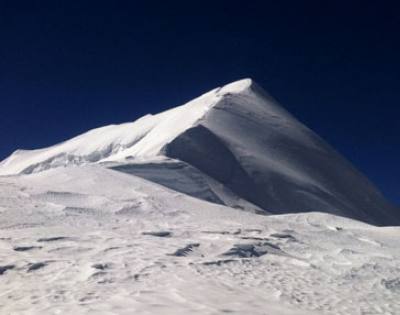- Read Reviews onTripadvisor
- Phone & WhatsApp Support+977 9851112535 (Chandra Shor)
Chulu Far - East Peak Climbing [6,059m/ 19,878 ft] | 19 Days
Fact Information
- Duration
- 19 Days
- Destination
- Nepal
- Difficulty
- Difficult
- Accommodation
- Hotel, Lodge &Tent
- Activity
- Home Stay
- Transportation
- Tourist Bus, Car, Jeep, Air-plane
- Meals
- BLD (Breakfast, Lunch and Dinner)
- Max Person
- 15
- Min Person
- 2
- Maximum altitude
- [6,059m/19,878 ft]
- Best season
- Autumn & spring
About Trip
Chulu Far East Peak is an enthralling and adventurous trekking peak in Nepal, standing at 6,060 meters (19,882 ft) above sea level. It is located in the northeast of the Annapurna Himalayan range, within the Damodar Himalaya range and near the village of Manang. The first ascent of Chulu Far East Peak was made on April 22, 1955, by a German expedition led by Harald Biller. The team members who reached the summit were Franz J. Dengler, Adolf Diemberger, Hans J. Ertl, Jürgen Wellenkamp, and a Nepali Sherpa guide.
The climbing trip begins with a long and scenic bus ride from Kathmandu to Chame, via the busy Prithvi Highway and the Annapurna Classic Trail to Manang. To reach Chulu Far East Peak base camp, the trail passes through the captivating Marsyangdi River Valley, which includes eye-catching terraced rice fields, numerous villages, crystal-clear perennial rivers, summer grazing lands for yaks and horses, ancient Tibetan villages, tea houses, spiritual Hindu temples, gompas, and mane walls.
The peak itself is moderately difficult to climb, with 75 to 85-degree ice and snow slopes and crevasses. Climbing equipment required includes fixed line ropes, Jumars (ascender devices), ATC guides or Figure 8s (belay devices), crampons, harnesses, regular ice axes, helmets, carabiners, and safety ropes. Novice climbers can also make it with the support of fixed line ropes, while skilled climbers may not need support on the slopes.
The climbing route to Chulu Far East Peak follows the normal route, the northeast ridge, with full support of fixed ropes for safety. It is quite challenging for beginner climbers, but with proper preparation and the support of an experienced, skilled, and trustworthy guide, anyone can make it to the summit.
During the climbing trip, climbers will spend most nights in lodges and a few nights in tented camps. The base camp is set up at an altitude of 4,800 meters, while the high camp is set up at an altitude of 5,400 meters. Each member has an individual dome tent made in Nepal with a waterproof compact mat. The dining tent, toilet tent, and other necessary facilities are also provided.
Note: Climbing Chulu Far East Peak not only provides a rewarding adventure experience but also offers a unique cultural and nature trekking experience.
To have a successful trip, a good level of physical fitness, proper acclimatization, and well-equipped participants are required. With proper training and guidance, adventurous climbers can conquer it.
To ensure a safe, successful, and enjoyable climbing trip, our team at Himalaya Diamond Adventure delivers high-quality climbing services at a very reasonable price. We offer luxurious base camp services for your comfortable stay, and our experienced and skilled professional guides lead you to the summit for a safe and successful climb. If you are looking for a good and trustworthy guide and service, look no further, and please do not hesitate to contact us. We are available 24 hours a day to serve you.
Trip Highlights
Stunning landscapes and diverse flora and fauna: The trek to Chulu Far East Peak base camp and the Annapurna Round trip offer breathtaking views of the Himalayan range, including Annapurna and Dhaulagiri, as well as unique cultures, diverse flora and fauna, waterfalls, and traditional villages.
Aerial viewing flight: The journey concludes with an enchanting aerial viewing flight over the beautiful villages of Marpha and Kalapani, as well as the high pass of Ghorepani Poon Hill (3,110 meters), providing breathtaking views of the Himalayas, including Dhaulagiri and Annapurna - towering mountains.
Challenging climb: Chulu Far East Peak is a moderate to challenging climb, with 75 to 85-degree ice slopes and crevasses, making it a thrilling adventure for experienced climbers.
Cultural experience: The trek passes through ancient Tibetan villages, tea houses, spiritual Hindu temples, and gompas, providing a unique cultural experience.
Thorong La Pass: Crossing the popular Thorong La Pass 5,416 meters, one of the highest passes in the Annapurna classic trekking trail, is an unforgettable experience.
Panoramic mountain views: The climb to the summit of Chulu Far East Peak and the Annapurna Round trip offer spectacular panoramic mountain views, including Annapurna I to IV, Gangapurna, Glacier Dome, Tilicho, Dhaulagiri, and Manaslu.
Camping and lodge stays: The trip involves spending nights in lodges and tented camps, providing an opportunity to experience the rugged beauty of the Himalayas up close.
Professional guidance and support: Professional guides and climbing equipment are provided to ensure the safety and success of the climb.
Outlined Itinerary
Day 01: Arrival in Kathmandu 1,350 meters (4,429 ft), transfer to hotel.
Day 02: Today is the day to prepare our climbing gear for the ascent.
Day 03: Bus journey Chame 2,670m (8,760 ft) about 250km, 10/11hrs.
Day 04: Trek to Pisang village 3,200 meters (10,498 ft), 4 hours.
Day 05: Trek to Ngawal 3,657 meters (12,057 ft), 4hrs.
Day 06: Acclimatization Day.
Day 07: Trek to Yak Kharka 3,740 m (12,270 ft), 3hrs.
Day 08: Trek to Base camp 4,800 m (15,748 ft), 4hrs.
Day 09: Entirely day, for acclimatization and climbing practice.
Day 10: Move to high camp 5,400 meters/ (17,716 ft), 3hrs.
Day 11: Push summit and climb back to base camp.
Day 12: A Contingency day.
Day 13: Trek from Manang to Chuli Ledar 4,200 m (13,779 ft) 5hrs.
Day 14: Trek from Chuli Ledar to Thorong High Camp 4,925 m (16,158 ft) 4hrs.
Day 15: Trek over Thorong La pass 5,416 m (17,769 ft) descend to Muktinath
Day 16: Trek from Muktinath to Jomsom 2,720 m (8,923 ft) 7hrs.
Day 17: Fly to Pokhara 820 m (2,690 ft) transfer to hotel.
Day 18: Sightseeing around Pokhara valley.
Day 19: Fly to Kathmandu 1,350 m (4,429 ft), transfer hotel.
Day 20: Departure to Home.
Detailed Itinerary
Day 01: Arrival in Kathmandu Airport 1,350 meters (4,429 ft), transfers to hotel.
Representatives from Himalayan Diamond Adventures will greet you upon your arrival at Tribhuvan International Airport in Kathmandu. You will be welcomed with a fresh flower garland, a traditional Nepali greeting, and then escorted to the hotel for bed and breakfast service. The drive from the airport to the hotel takes approximately 15 to 20 minutes, if there is no traffic jam on our way. After checking into the hotel, we will have a short refreshment meeting at the hotel. In the evening, the company will host a welcome dinner at a traditional Nepali restaurant, complete with a cultural dance performance, to celebrate the start of your trip. During the dinner, your guide will provide a brief overview of the schedule for the following day.
Day 02: Today is the day to prepare our climbing gear for the ascent.
Today is the final hour of our trip preparation day. If you are not well-equipped, it is a good idea to gather climbing gear before departing for a mountain trip.
There are many shops in Thamel Bazaar that sell trekking gear and equipment, where you can purchase everything, you need, or rent it. If you decide to rent, you will need to leave a deposit at the trekking shop.
Day 03: A scenic bus journey to Chame 2,670 meters (8,760bft), about 250 kilometers, 10 to 11hrs.
A scenic bus ride from Kathmandu through Besishahar will take us to Chame, the headquarters of Manang district. The journey begins on the highly busy Prithibi highway and then links to the Beshisahar- Annapurna circuit trail Manang. Along the way, we can enjoy splendid views of the mountain terrain, including the Ganesh Himal range, Baudha Himal, Rani peak, Himalchuli ranges, Ngadichuli, and Manasalu. Besides the majestic Himalayas, we can also see many beautiful perennial rivers, tributaries, captivating waterfalls, rolling green hills, subtropical forests, cultivated terraced lands, and colorful villages. After a 10 to 11-hour journey, we can stay overnight at a lodge in Chame.
Day 04: Trek to Pisang village 3,200 meters (10,498ft), 4 hours of comforting walk.
Today, we have two options to reach Pisang, an ancient Tibetan Buddhist inhabited village. One is to walk along the newly opened road, and the other is to take a jeep. If we take a jeep, we can reach there within 30 to 45 minutes, while walking will take us about 4 hours. However, our trail follows the narrow Marsyangdi river valley, providing stunning views of the enormous cliffs, including a superb view of Lamjung Himal and Annapurna II. As we leave the treeline, we will pass through large apple gardens, and the trail gradually ascends towards a place with a more prominent snowline.
Before reaching Pisang Village, we will be greeted with an iconic view of Pisang Peak, and Chulu East can be seen in the distance. After reaching Pisang, we can hike to Upper Pisang to gain altitude and enjoy breathtaking views, including mesmerizing views of Annapurna II (7,937 meters), Annapurna IV (7,525 meters), and Annapurna III (7,555 meters).
Day 05: Trek to Ngawal 3,657 meters (12,057 ft), along the viewing trail, 4 hours.
Our day starts by crossing the perennial Marshyangdi River over a suspension bridge and then continuing along a narrow path that slightly ascends through the blue pine forest until we reach the next well-made suspension bridge. At this point, we will have our first view of the captivating Tilicho Snowy Mountain. After crossing the bridge, the trail steeply climbs up to the ancient Tibetan village of Ghyaru. Today, we will trek through isolated Tibetan and Gurung villages with spectacular panoramic views of the Annapurna Himalayan range, Pisang Peak, Tilicho Peak, Manang Himal, and, most notably, the iconic Annapurna Himalayan range throughout the day. Along the way, we will come across many beautiful Buddhist Chortens, mane walls, monasteries, and cultivated farmlands. After 3 to 4 hours of glorious trekking with stunning views, we will reach the old Tibetan village of Ngawal.
Day 06: Acclimatization Day:
Today is an acclimatization day, and it is crucial to take a break at the same elevation after rapidly ascending in the mountains. After our morning breakfast, we will hike uphill to acclimatize while enjoying the best panoramic views of the mountains.
Day 07: Trek to Yak Kharka 3,740 meters (12,270 ft), walk 3 hours.
After our usual breakfast, we will start our trek to Yak Kharka, passing through farmers' cultivated lands, pine, birch, and juniper forests along a gradually ascending trail. After trekking for 3 hours, we will reach Yak Kharka, which is located at an elevation of 3,740 meters (12,270 ft) from Ngawal. After having our lunch, we will hike to the base camp, which is situated at an elevation of 4,800 meters (15,748 ft), for acclimatization. We will return to Yak Kharka in the evening and spend the night at a tented camp. Dinner and breakfast, along with a hot drink, will be included in the service.
Day 08: Trek to Base camp 4,800 meters (15,748 ft), climb up 4 hours.
Today, we will wake up earlier than usual for an early breakfast and leave early for the base camp. We will start our day by crossing a small wooden bridge at Yak Kharka, and then the path steeply ascends uphill through the summer grazing lands of yaks and horses. The trail will lead us through gentle slopes of ground-hugging bushes and rocky and scree steep slopes before finally ending in a steep uphill climb to reach the base camp. Today's trek is comparatively more strenuous, although it rewards us excellent backdrop views. We will be staying in a tent camp with full board service for the night.
Day 09: During the entire day, we will focus on acclimatization and climbing practice.
Today is an acclimatization and climbing practice day. After our usual breakfast, we will demonstrate how to rack and pack your gear, create proper anchorage, and move on the slope. We will also provide specifications for the necessary gear such as the rope capacity, harness, tape sling, carabiner, figure of 8, and anchorage. Additionally, we will share some climbing techniques with you. We will stay at a tented camp that includes full board service.
Day 10: Head to high camp 5,400 meters (17,716 ft), 3 hours of climb on scree slope:
After acclimatizing and practicing climbing skills at the base camp, we will be heading towards the high camp at 5,400 meters (17,716 ft). The path gradually ascends throughout the day until we reach the high camp. Although today will be quite challenging due to the decreasing oxygen levels, the landscape will be breathtaking throughout the day. After approximately 3 hours of climbing and enjoying the surrounding mountain views, we will reach the high camp where we will be staying in a tented camp with full board service.
Day 11: Attempt top with support of fix line rope and descend back to base camp:
Today, we are extremely excited to attempt the summit. We will wake up early in the morning, around 3 am, for tea and a light breakfast, as well as to prepare for the climb. We will begin our climb at around 4 am, using headlamps. In the first phase, we will climb the peak with the support of the guide rope, and finally, we will climb with the support of fixed line ropes to reach the summit. The climbing route is challenging, particularly in the spring season when crevasses are present, but the view from the top of the peak is undoubtedly magnificent. The summit provides not only a lifetime climbing experience but also a rejuvenating aura and a breathtaking landscape. From an altitude of 6,039 meters (19,812 ft), we will enjoy mesmerizing views of the Annapurna range, including peaks I-IV, Lamjung, Manasalu, Kangaru Himal, Himlung, Manang Himal, Tilicho Himal, Tibet border Himalaya, Nar-Phu, and the gorgeous Manang Valley.
Day 12: A Contingency day:
The 11 day of our itinerary is reserved as a contingency day in case our Chulu far East Peak climbing doesn't go as planned due to unfavorable weather or any other reasons. If we are lagging behind on the itinerary, we can compensate for it today. However, if we are right on schedule, we will simply move ahead as planned.
Day 13: Today, we will trek back to Manang village to continue our journey.
After successfully climbing Chulu far East Peak, we will return to Manang village to continue our journey towards Thorong La pass, Mustang, and the Kaligandaki valley. This evening, we will celebrate our successful climbing trip by enjoying some Yak meat steak and a few bottles of beer in Manang.
Day 14: Trek to Chuli Ledar 4,200 meters (13,779 ft), 5 hours gently uphill trail. Stay at the lodge:
Today, the trail will gradually ascend towards Tengki Manang, offering fine views of Manang village behind us, the crystal clear Marsyangdi river, and the greenish-blue Gangapurna Lake. We will continue trekking from the Marsyangdi River valley to Chuli Ledar Lodge, passing through the summer Yak grazing lands of Yak Kharka. The views are breathtaking with the Annapurna range and the snowy Tilicho Mountain beyond the Manang Himal. While trekking to the Thorong La pass, we might even spot some rare wildlife such as Snow leopards, Blue sheep, and Himalayan griffons on the way. After about 5 hours of relaxing and spectacular trekking, we will reach the Chuli Ledar Lodge, which is located at the base of the Chulu West peak.
Day 15: Push to Thorong High Camp 4,925 meters (16,158ft), 3 to 4 hours of relaxing walk.
Today is a relaxing day for us before we tackle the high pass of Thorong La at 5,416 meters. Our journey will begin by following a narrow and slightly inclined trail that crosses the suspension bridge over Kone Khola at the corners of Phedi. Along the way, we may come across rock fall zones and frozen streams during winter. Before we start climbing up, we will reach New Phedi, which overlooks the grazing lands of yaks and blue sheep. At the base of the High Camp, there are some tea houses where we can stop to eat and recharge our energy before the steep climb. From there, we will ascend uphill to the High Camp primitive lodge. The ascent can be challenging, but the stunning landscape makes it all worthwhile. At the High Camp, there is a small viewpoint that offers a substantial view of Chulu West trekking peak, which stands at 6,419 meters. Chulu West is a popular trekking peak in the Annapurna classic circuit trekking route.
Day 16: Trek out before the sunlight comes up to cross the Thorong La pass at 5,416 m, descend to Muktinath at 3,760 m.
Today, we will wake up early in the morning, around 5:00 A.M., and have a light, warm breakfast with a cup of tea. After breakfast, we will begin our ascent of the popular Thorong La pass at an altitude of 5,416 meters. The trail from High Camp gradually climbs the mountainside and after 3 to 4 hours, we will reach the pass, which is indicated by prayer flags and stone cairns. Note that the pass is usually snowbound during the winter season (mid-December to late February).
After enjoying the outstanding views from the highest pass of the Annapurna region, we will begin our descent to Muktinath. The trail steadily drops to Phedi, which is located at the bottom of the hill. Along the way, we will have wide, superb views of the Mustang valley and the eye-catching Khatungkang peak, which stands at 6,484 meters (21,273 ft).
We will continue descending for 2 to 3 hours before stopping at Phedi for a hot lunch and some relaxation time. Afterward, we will resume our descent towards Muktinath, a holy shrine revered for salvation and spiritual fulfillment. Muktinath is a beautiful holy town.
Day 17: Trek to Jomsom 2,720 meters (8,923ft) 7 hours of a downhill walk with a splendid dry landscape to Kaligandaki.
Finally, we will trek down to the base of the Kali Gandaki River, passing through Jharkot and Kagbeni, which serve as the main entry gateways to the Upper Mustang Valley. As we trek down, we will be treated to breathtaking views of cultivated lands, hills, Tilicho, and Nilgiri, providing an unforgettable trekking experience. After sightseeing in Kagbeni village, we will continue our trek to Jomsom, the headquarters of the Mustang district, following the Kaligandaki River. After 7 to 8 hours of trekking from Muktinath, we will finally reach the windy valley of Jomsom, one of the best tourist destinations in Nepal.
Day 18: Scenic flight; Jomsom to Pokhara 30 minutes 820 meters (2,690ft) transfer to hotel.
Early in the morning, we will take a 30-minute scenic flight from Jomsom to Pokhara, which offers breathtaking views of the Annapurna (8,091 meters), Dhaulagiri (8,167 meters), Nilgiri (7,060 meters), Annapurna South (7,219 meters), Machhapuchhre (6,997 meters), and other stunning mountains. Alternatively, we can take a Jeep from Jomsom to Beni and then travel by micro bus from Beni to Pokhara to reach our destination in a single day. We will spend the night at a lodge in Pokhara.
Day 19: We will have a Pokhara valley tour.
We will spend the full day exploring the beautiful Pokhara valley, visiting popular attractions such as the Peace Stupa, David Falls, and the International Mountain Museum. These sights offer stunning views of the surrounding mountains and cultural insights into the local communities. We will have plenty of time to take photos, learn about the history and significance of each site, and enjoy the natural beauty of Pokhara. Overnight stay in Pokhara.
Day 20: Drive back to Kathmandu 1,350 meters (4,429ft), 6 to 7hours by tourist bus and transfer to hotel
After the unforgettable Annapurna Circuit Classic Trek, we will take a scenic 6-hour bus journey from Pokhara to Kathmandu. In the evening, we will organize a farewell dinner at a traditional Nepali restaurant. Alternatively, you may choose to take a short flight from Pokhara to Kathmandu for a more convenient travel option.
Day 21: Departure to Home.
As per your international flight checking time, we will drop you off to the international airport and see you off.
Note:- The conditions stated in the itinerary mainly apply to trekkers who prefer a full package service. However, we also offer services based on your preferences. The choice of itinerary and staff depends on your needs and financial capacity. We have options for partial visits based on your requirements and
Cost Details
What's included
- 1. Airport pickup and drop off by the private vehicle as per your itinerary.
- 2. 3 Overnight Hotel Moonlight in Kathmandu included breakfast.
- 3. Transportation: Kathmandu to Chame and Pokhara to Kathmandu by tourist bus and Jeep.
- 4. The menu on client’s choice, Three meals in a day (Breakfast, Lunch, Dinner & Fresh fruits), with
- (hot drinks, like tea, Coffee, Ginger lemon, Ginger lemon tea, Ginger lemon honey, hot chocolate,
- milk tea, milk coffee, hot water).
- 5. T- house accommodations during the trek, clean and comfortable.
- 6. Entry permit fees: Peak permit, ACAP, TIMS and Garbage deposit fees.
- 7. Jomsom to Pokhara flight fare with 15 kg cargo
- 8. Pokhara airport to hotel and hotel to tourist bus station vehicle service
- 9. 2 Overnight Pokhara hotel included breakfast
- 10. One day Kathmandu valley sightseeing like Pashupatinath, Swoyanbhunath, and Baudhanath
- stupa with city guide with transportation.
- 11. Guide: Equipment $300
- 12. BC and HC full board services: Specious Two men sharing Nepal made box tent, comfortable mat,
- dining hall, arm chair, clean table with solar light, EP Gas, Stove and high foods.
- 13. Grouping Climbing gears: Tent, high foods, EP gas, cooking pot, stove, dynamic Ropes, static
- Ropes, Snow bar, Ice crew, Carabineers, Runners, Rock Pitons, Auxiliary cords.
- 14. One Strong and helpful porter between two members with proper equipment, Warm clothing
- and required trekking gear for porters like Gore-Tex jacket/ trousers, trekking shoes, woolen hat,
- woolen gloves, woolen socks, sunglasses, etc.
- 15. Nepalese staff’s insurance policy covered emergency rescue evacuation helicopter,
- Hospitalization, medical treatment and accidental.
- 16. Medical supplies (first aid kit will be available).
- 17. Company's complimentary: Duffle bag, Map and company T-short.
- 18. Hot bag services.
- 19. Government taxes and official expenses.
- 20. Welcome dinner and farewell dinner in Nepali cultured restaurant
What's not included
- ❖ Personal trekking equipment and gears.
- ❖ Nepal entry visa fee.
- ❖ International airfare bill.
- ❖ Extra night accommodation in Kathmandu because of early arrival, late departure, early return from mountain (due to any reason) than the
- ❖ Meals while you stay in Kathmandu Hotel Lunch and Dinner.
- ❖ Your travel insurance policy should be covered rescue evacuation, medical treatment and accidental.
- ❖ Any entry fee for the temple or monastery.
- ❖ Donations or charity.
- ❖ Your personal expenses like; Hot shower, Laundry, Battery charging, telephone, WIFI, and shopping, etc.
- ❖ Alcoholic and non-alcoholic alcoholic hot and cold drinks.
- ❖ Tips for the guide, porter, and driver (tipping is expected)
Client Review
Useful Info
What Essential Documents Do I Need To Bring With Me On Tour?
When going on a tour, it's important to bring essential documents to ensure a smooth and hassle-free trip. Here are some documents that we highly recommend you bring with you.
Passport: When traveling to a foreign country, it is important to ensure that you have a valid passport with at least 6 months validity remaining before its expiration date and at least 2 blank visa pages. This is because many countries require that your passport is valid for at least six months beyond your expected departure date and has sufficient blank pages for visa stamps and entry/exit stamps.
Visa: Depending on your destination, you may need a visa to enter the country. Check with the embassy or consulate of the country you're visiting to see if you need a visa. Visit the official website of the Department of Immigration of Nepal at https://www.immigration.gov.np/page/tourist-visa
Travel itinerary: It's always a good idea to have a printed copy of your travel itinerary, including flight and hotel reservations, tour bookings, and any other important travel plans.
Travel insurance: As a traveler, it is advisable to purchase a comprehensive travel insurance package that covers potential medical issues, personal accidents, emergency helicopter evacuation, loss or damage of personal belongings, and trip cancellations, especially if you are planning to trek to high altitudes up to 5,500 meters, such as Everest Base Camp. It is also important to ensure that the insurance covers the cost of cancellation for both your international flight and the trek. The minimum recommended coverage amount is USD 100,000. Many insurance companies offer travel insurance services online, so you can easily find a plan that meets your needs.
COVID-19 vaccination certification: To obtain a Nepal tourist visa during the ongoing pandemic, travelers need to show either a completed COVID-19 vaccination certificate with a QR code or a negative PCR test result taken within 72 hours of boarding.
Health documents: If you're traveling to a country with specific health requirements, such as a yellow fever vaccination, make sure to bring the necessary health documents.
Driver's license: If you plan on driving while on tour, make sure to bring your driver's license.
Credit cards and cash: Bring enough cash and credit cards to cover your expenses while on tour.
Emergency contact information: Write down the contact information for someone you trust in case of an emergency. This could include a family member, friend, or employer.
It's always a good idea to make copies of all your important documents and keep them in a safe place in case the originals get lost or stolen. Additionally, you may want to consider using a travel document organizer to keep all your important documents organized and easily accessible.
If you are traveling to Nepal, then here are some essential documents you will need to have with you in order to ensure a smooth and hassle-free trip.
What Essential Documents Do I Need To Bring With Me For this climbing Trip?
❖ Valid passport with at least 6 months validity and at least 2 blank visa pages
❖ Travel insurance policy document
❖ Photocopies of your passport's personal information page
❖ One or more recent passport-sized photos with a white background (1.5 inch x 1.5 inch)
❖ Completed and signed Nepal visa application form
❖ Proof of accommodation in Nepal (such as a hotel reservation or address)
❖ Valid return flight or travel ticket
❖ Proof of sufficient financial means, such as recent bank statements
❖ Mastercard, Visa, and some cash in USD
❖ Proof of payment of the Nepal visa fee
❖ To obtain a visa for Nepal, your passport must be valid for at least 6 months from the travel date and you must present either a completed COVID-19 vaccination certificate with QR code or a valid PCR test negative result taken within 72 hours prior to boarding.
How to apply for an online tourist visa to Nepal?
Visit the official website of the Department of Immigration of Nepal at https://www.immigration.gov.np/page/tourist-visa
1. Fill out the online application form with your personal information, including your name, date of birth, nationality, passport number, and intended travel dates.
2. Upload a recent passport-size photograph in JPEG or PNG format.
3. Pay the visa fee online using a credit card or debit card. The cost of the visa depends on the length of your stay in Nepal, but it typically ranges from $30 to $125.
4. Once you have submitted your application and payment, you will receive a confirmation email with a receipt and an application ID.
5. After your application has been processed, you will receive another email with a link to download your visa. You should print out the visa and carry it with you when you travel to Nepal. It's important to note that the online tourist visa is valid for multiple entries and is valid for 15, 30, or 90 days, depending on your length of stay. Also, be sure to apply for your visa well in advance of your travel date to allow time for processing.
What Type Of Insurance Should I Get?
It is essential for foreign travelers to secure insurance coverage while trekking or climbing in Nepal. Although trekking in Nepal is generally safe, travel insurance is compulsory for mountaineering activities in Nepal. The trip can pose physical challenges and hazards, particularly at high altitudes where altitude sickness is prevalent among trekkers and climbers, especially those who have not acclimatized properly. Physical injuries can also occur on mountain trails or during climbing activities, and in emergency situations, foreign trekkers or climbers may need to be rescued by helicopter and transported to hospitals in Kathmandu, which can be costly if the traveler does not have insurance coverage.
We strongly recommend purchasing a travel insurance package that covers high altitudes up to 6,000 meters, potential medical issues, natural disasters, personal accidents, emergency helicopter evacuation, loss or damage of personal belongings, and trip cancellations. The minimum recommended coverage amount is USD 100,000. There are many insurance companies that offer travel insurance services online. You should compare plans to find the one that best meets your needs.
What Are Some Popular And Highly Rated Travel Insurance Companies?
If you are in search of popular and highly-rated travel insurance companies, then we can recommend some based on positive feedback we have received from our previous travelers. It is here. [Company 1], [Company 2], [Company 3]............................
For Travelers from USA and CANADA........................
Online Global Health Insurance
Travelex
Insure My Trip.com (Online Insurance Aggregator)
Mondial Assistance
Access America
HCC Medical Insurance Services
Good Neighbor Insurance (International Health)
International Health
Insuremytrip dot com
MultiNational Underwriters
TIC Travel Insurance Coordinators Ltd
Travel Assist
TraveLite
For Travelers from England...................................
Specialty Group (UK) Limited
FirstAssist Services Limited
Harrison Beaumont
Buy cheap travel insurance
For Travellers from EUROPE and SLOVENIA...........................
Assistance CORIS
For Travellers from AUSTRALIA and NEW ZEALAND
Cover More Travel Insurance
CGU Insurance Limited
For Travellers from SOUTH AFRICA........................................
Travel insurance Consultants Pty. Ltd.
What are the weather conditions and temperatures like in Nepal?
As Nepal's topography is divided into three geographical regions - Terai, Hills, and Mountains - each region experiences different temperatures during different seasons. Below is a tabular illustration of temperature changes throughout the different seasons in Nepal, which will allow you to better understand the changing weather conditions.
Seasons Minimum temperature (approx) Maximum temperature (approx) Weather Condition
Spring 4°C/ 39°F (Mountain) 20°C/ 68°F (Mountain) Moderate with occasional rain
Summer 12°C/ 53°F (Mountain) 25°C/ 77°F (Mountain) Extreme high with heavy rain
Autumn 3°C/ 37°F (Mountain) 18°C/ 64°F (Mountain) Moderate
Winter 10°C/ 50°F (Terai) -4°C/ 24°F (Mt.) 20°C/ 68°F (Terai) to 12°C/ 53°F (Mountain) Extreme low
What Is The Best Time To Trek In Nepal?
After a thorough analysis of all the seasons, it has been suggested that autumn is the best time of the year to trek in Nepal. The mild temperatures from September to November make the trekking experience more enjoyable. During this time of the year, trekking routes throughout the country are jam-packed with travelers from all around the world.
However, as mid-December is generally the holiday season in most countries, including the United States, there is a spike in the number of international tourists during early winter as well. Interestingly, to make the holiday season even more special, travel companies offer some of the best holiday destination packages during this time. So, be sure to take advantage of the best travel opportunities with the assistance of Himalayan Diamond Adventure.
Nonetheless, if you cannot make it in autumn, spring also allows for favorable conditions for trekking in Nepal. The warmer days and nights, lush plants and vegetation, and clear trekking trails during spring make the trek worthwhile. However, the downside is occasional rain and slightly higher temperatures in the lower elevations. All in all, after autumn, spring is the second-best time to trek in Nepal.
Best time to trek in Nepal:
Thousands of tourists visit Nepal every year to enjoy the picturesque nature and trek through the adventurous and diverse terrain. However, the best times to trek in Nepal are autumn (September to November) and spring (March to May). During these seasons, travelers are blessed with moderate temperatures and enjoyable weather conditions throughout the country.
As calm as it may seem, the challenging terrains of the Himalayas in Nepal can present trekkers with gruesome scenarios during harsh weather conditions. To avoid any unforeseen situations and to enjoy nature at its best, most trekkers prefer autumn for backpacking. However, it may not be the best time of the year to trek in Nepal for everyone. Some may prefer off-season trekking to avoid the crowds. Therefore, exploring the various seasons can help you choose a favorable time for trekking in Nepal based on your preferences.
Trekking Seasons in Nepal
Throughout the year, the landscape of Nepal experiences four seasons, each with its own uniqueness that brings significant changes to the natural environment. Below are some detailed insights into the four seasons in Nepal.
1. Spring Season (March-May)
Spring in Nepal lasts from March to May and is one of the preferred seasons for trekking throughout the country. During this time, the climate is moderate, with slightly higher temperatures reaching up to about 32°C (89°F) in the lower elevation regions and around 20°C (68°F) at higher altitudes. The sky is usually clear with mild days and occasional rain.
Spring brings a rejuvenation of nature. Flowers begin to blossom, trees become lusher with newly sprung leaves, and spring vegetation sprouts again. Likewise, the flora and fauna of the Himalayan terrain also resuscitate from the harsh winter. Overall, spring is considered a great time for trekking in Nepal due to the alluring freshness of nature.
2. Summer Season (June-August)
With the end of May, summer starts in Nepal and lasts from June to August, which is also the monsoon season in the country. During these months, the weather can be harsh, with scorching heat and heavy rain throughout the nation. The rising humidity and extreme hot weather conditions may restrict travelers from fully enjoying their trip.
Although the lower elevation regions experience harsh summers, the Himalayan terrains are not as brutal. In the mountain regions, temperatures can range from approximately 25°C to 12°C (77°F to 53°F). However, heavy rains can make trekking through rocky mountain terrain challenging, and the cloudy sky may obscure mountain views.
3. Autumn Season (September-November)
With the arrival of autumn from September to November, Nepal becomes a popular destination for trekking. During this season, the weather is usually pleasant with clear skies, moderate temperatures, and gentle sunshine throughout the day. However, early autumn may bring occasional light rainfall. As the season progresses into October and November, the monsoon season completely ends, and cooler weather conditions prevail.
Many people choose to trek to popular destinations such as Everest Base Camp, Annapurna Base Camp, and Poon Hill during this season. Additionally, autumn is festival season in Nepal, and visitors can witness major celebrations such as Dashain and Tihar, which provide an opportunity to experience Nepali culture and traditions. Many travel packages are available for the best treks in Nepal during this season, and our travel experts can help you plan your trip to align with the festival season.
4. Winter Season (December-February)
Winter, which lasts from December to February, is the harshest season for trekking in Nepal. As the temperature drops in December, nights become chilly, and temperatures can reach around 9°C (48°F) during the day and below 0°C (32°F) during the night in higher altitudes. During peak winter, many high passes and trekking routes in the mountains are covered with dense fog and snow, increasing the risk of unexpected accidents.
Because of the risks of unpleasant trekking conditions, most travelers avoid trekking in the Himalayan terrains during the winter season. Additionally, most expeditions and mountain climbing, including trekking in the Everest region, also come to a halt during the harsh winter. Overall, it may not be the best time to trek due to the challenges presented by the weather conditions.

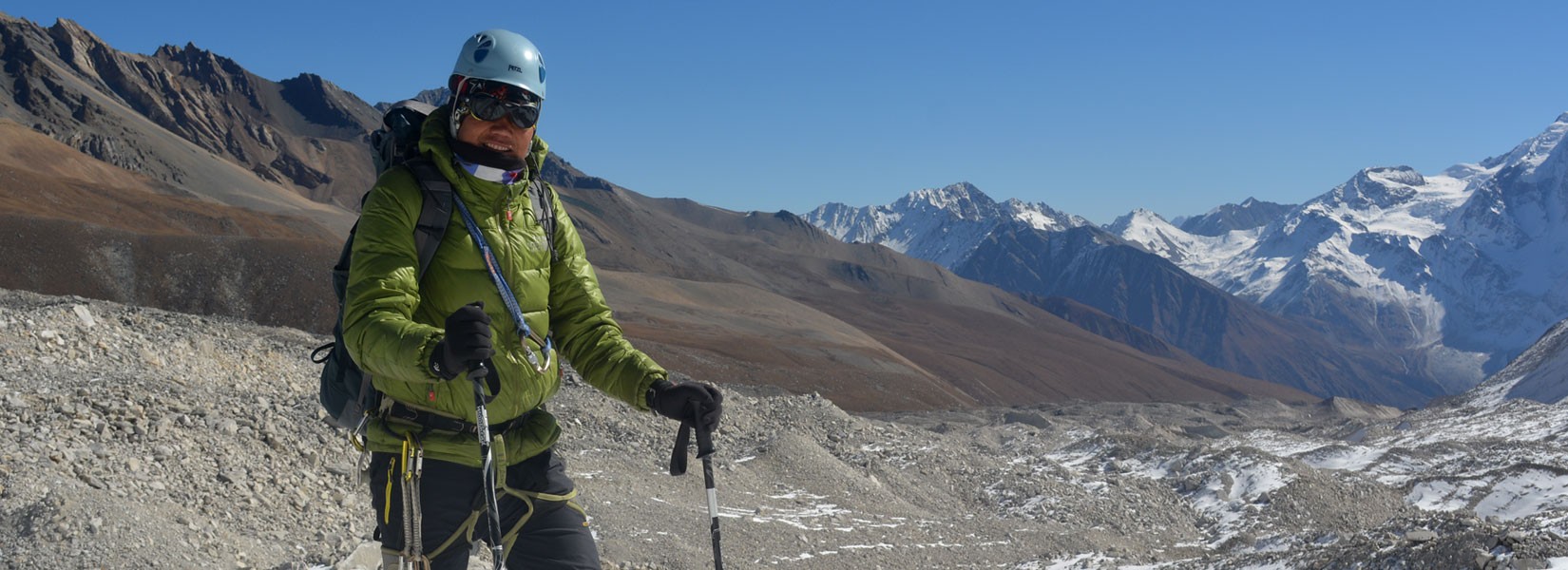
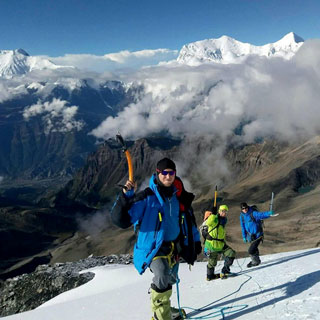
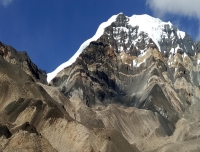
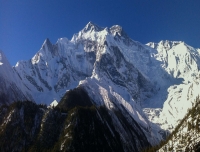
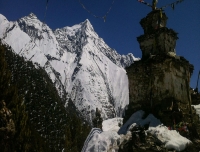
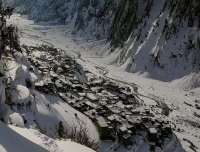
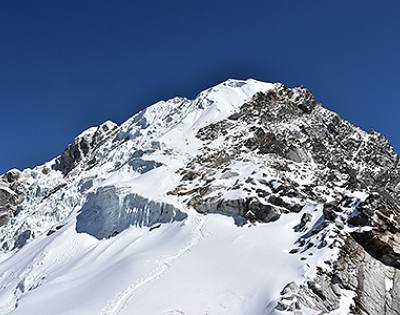
![Tent Peak (Tharpu Chuli) [5,695m/18,684ft]](https://www.himalayandiamond.com/uploads/package/tent-peak.jpeg)
